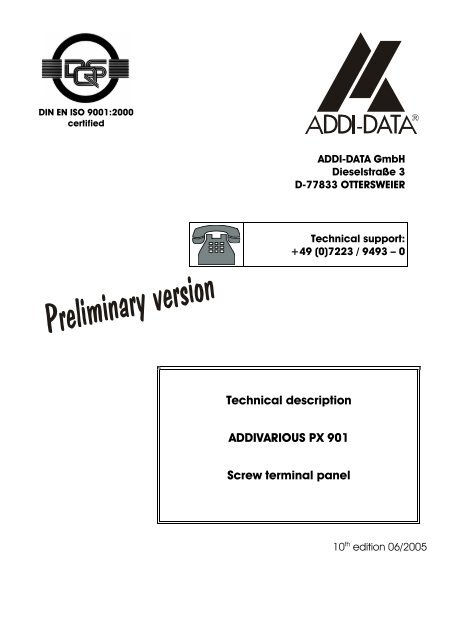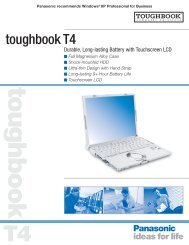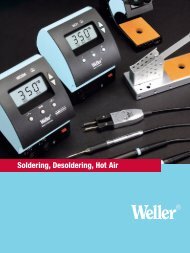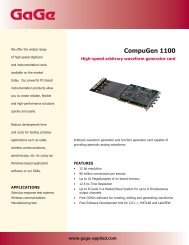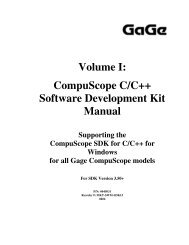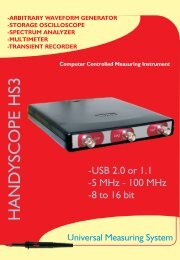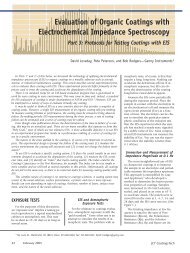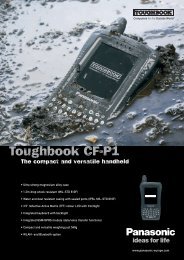5.5 Connection to the PX 901-ZG - Egmont Instruments
5.5 Connection to the PX 901-ZG - Egmont Instruments
5.5 Connection to the PX 901-ZG - Egmont Instruments
- No tags were found...
You also want an ePaper? Increase the reach of your titles
YUMPU automatically turns print PDFs into web optimized ePapers that Google loves.
DIN EN ISO 9001:2000certifiedADDI-DATA GmbHDieselstraße 3D-77833 OTTERSWEIERTechnical support:+49 (0)7223 / 9493 – 0Technical descriptionADDIVARIOUS <strong>PX</strong> <strong>901</strong>Screw terminal panel10 th edition 06/2005
Product informationThis manual contains <strong>the</strong> technical installation and important instructions for correct commissioningand usage, as well as production information according <strong>to</strong> <strong>the</strong> current status before printing.The content of this manual and <strong>the</strong> technical product data may be changed without prior notice.ADDI-DATA GmbH reserves <strong>the</strong> right <strong>to</strong> make changes <strong>to</strong> <strong>the</strong> technical data and <strong>the</strong> materialsincluded herein.Warranty and liabilityThe user is not permitted <strong>to</strong> make changes <strong>to</strong> <strong>the</strong> product beyond <strong>the</strong> intended use, or <strong>to</strong> interfere with<strong>the</strong> product in any o<strong>the</strong>r way.ADDI-DATA shall not be liable for obvious printing and phrasing errors. In addition, ADDI DATA, iflegally permissible, shall not be liable for personal injury or damage <strong>to</strong> materials caused by improperinstallation and/or commissioning of <strong>the</strong> board by <strong>the</strong> user or improper use, for example, if <strong>the</strong> board isoperated despite faulty safety and protection devices, or if notes in <strong>the</strong> operating instructions regardingtransport, s<strong>to</strong>rage, installation, commissioning, operation, thresholds, etc. are not taken in<strong>to</strong>consideration. Liability is fur<strong>the</strong>r excluded if <strong>the</strong> opera<strong>to</strong>r changes <strong>the</strong> board or <strong>the</strong> source code fileswithout authorisation and/or if <strong>the</strong> opera<strong>to</strong>r is guilty of not moni<strong>to</strong>ring <strong>the</strong> permanent operationalcapability of working parts and this has led <strong>to</strong> damage.CopyrightThis manual, which is intended for <strong>the</strong> opera<strong>to</strong>r and its staff only, is protected by copyright.Duplication of <strong>the</strong> information contained in <strong>the</strong> operating instructions and of any o<strong>the</strong>r productinformation, or disclosure of this information for use by third parties, is not permitted, unless this righthas been granted by <strong>the</strong> product licence issued. Non-compliance with this could lead <strong>to</strong> civil andcriminal proceedings.ADDI-DATA software product licencePlease read this licence carefully before using <strong>the</strong> standard software. The cus<strong>to</strong>mer is only granted <strong>the</strong>right <strong>to</strong> use this software if he/she agrees with <strong>the</strong> conditions of this licence.The software must only be used <strong>to</strong> set up <strong>the</strong> ADDI-DATA boards.Reproduction of <strong>the</strong> software is forbidden (except for back-up and for exchange of faulty datacarriers). Disassembly, decompilation, decryption and reverse engineering of <strong>the</strong> software areforbidden. This licence and <strong>the</strong> software may be transferred <strong>to</strong> a third party if this party has acquired aboard by purchase, has agreed <strong>to</strong> all <strong>the</strong> conditions in this licence contract and <strong>the</strong> original owner doesnot keep any copies of <strong>the</strong> software.Trademarks- ADDI-DATA is a registered trademark of ADDI-DATA GmbH.- Turbo Pascal, Delphi, Borland C, Borland C++ are registered trademarks of Borland InsightCompany.- Microsoft C, Visual C++, Windows XP, 98, Windows 2000, Windows 95, Windows NT,EmbeddedNT and MS DOS are registered trademarks of Microsoft Corporation.- LabVIEW, LabWindows/CVI, DasyLab, Diadem are registered trademarks of National <strong>Instruments</strong>Corp.- CompactPCI is a registered trademark of PCI Industrial Computer Manufacturers Group.- VxWorks is a registered trademark of Wind River Systems Inc.
WARNINGThe following risks result from improper implementationand from use of <strong>the</strong> board contrary <strong>to</strong> <strong>the</strong> regulations:♦♦♦Personal injuryDamage <strong>to</strong> <strong>the</strong> board, PC and peripheralsPollution of <strong>the</strong> environment♦♦♦♦Protect yourself, <strong>the</strong> o<strong>the</strong>rs and <strong>the</strong> environment!Read carefully <strong>the</strong> safety precautions(yellow leaflet).If this leaflet is not with <strong>the</strong> documentation, please contact usand ask for it.Observe <strong>the</strong> instructions of <strong>the</strong> manual.Make sure that you do not forget or skip any step. We are notliable for damages resulting from a wrong use of <strong>the</strong> board.Used symbols:iIMPORTANT!designates hints and o<strong>the</strong>r useful information.WARNING!It designates a possibly dangerous situation.If <strong>the</strong> instructions are ignored <strong>the</strong> board, PC and/or peripheral maybe destroyed.3
Contents <strong>PX</strong> <strong>901</strong>1 DEFINITION OF APPLICATION ............................... 81.1 Intended use ....................................................................82 USER .................................................................... 92.1 Qualification ....................................................................92.2 Personal protection..........................................................93 TECHNICAL DATA ............................................... 103.1 Physical set-up...............................................................103.2 Limit values.....................................................................104 LAYOUT .............................................................. 124.1 <strong>PX</strong> <strong>901</strong>-DG ......................................................................124.2 <strong>PX</strong> <strong>901</strong>-AG ......................................................................164.3 <strong>PX</strong> <strong>901</strong>-<strong>ZG</strong>.......................................................................185 CONNECTION TO THE ADDI-DATA BOARDS......... 195.1 General remarks ............................................................195.2 Signals of <strong>the</strong> 37-pin SUB-D female connec<strong>to</strong>r ..............195.3 <strong>Connection</strong> <strong>to</strong> <strong>the</strong> <strong>PX</strong> <strong>901</strong>-DG ........................................205.3.1 APCI-1032, APCI-1564 (dig. inputs), PA 1000 ...................... 205.3.2 APCI-1016 ........................................................................... 215.3.3 APCI-1500 and CPCI-1500 ................................................. 225.3.4 PA 1500............................................................................... 235.3.5 APCI-1516 ........................................................................... 245.3.6 PA 2000, APCI-2032, APCI-1564 (dig. outputs).................... 255.3.7 APCI-2016 ........................................................................... 265.4 <strong>Connection</strong> <strong>to</strong> <strong>the</strong> <strong>PX</strong> <strong>901</strong>-AG ........................................275.4.1 PA 3000............................................................................... 275.4.2 PA 302................................................................................. 275.4.3 PA 3100, PA 311, PA 3110................................................... 285.4.4 PA 358................................................................................. 285.4.5 APCI-3120 and CPCI-3120 ................................................. 295.4.6 APCI-3001 and CPCI-3001 ................................................. 305.4.7 APCI-3501 ........................................................................... 305.4.8 APCI-3003 ........................................................................... 315.4.9 APCI-3006 ........................................................................... 325.4.10 APCI-3010 ........................................................................... 325.4.11 APCI-3016 ........................................................................... 335.4.12 APCI-3106 ........................................................................... 335.4.13 APCI-3116 ........................................................................... 345.4.14 APCI-3500 ........................................................................... 344
Contents <strong>PX</strong> <strong>901</strong><strong>5.5</strong> <strong>Connection</strong> <strong>to</strong> <strong>the</strong> <strong>PX</strong> <strong>901</strong>-<strong>ZG</strong>.........................................35<strong>5.5</strong>.1 PA 1610 ...............................................................................35<strong>5.5</strong>.2 PA 160 .................................................................................35<strong>5.5</strong>.3 PA 1700-2 ............................................................................36<strong>5.5</strong>.4 APCI-3001, APCI-3120 (for digital I/O) ..................................37<strong>5.5</strong>.5 APCI-3501............................................................................37<strong>5.5</strong>.6 APCI-3002 (for digital I/O).....................................................38<strong>5.5</strong>.7 APCI-3003 (for digital I/O).....................................................386 CONNECTION EXAMPLES ...................................396.1 <strong>Connection</strong> <strong>to</strong> <strong>the</strong> <strong>PX</strong> <strong>901</strong>-DG ........................................396.1.1 Direct connection ...............................................................396.1.2 <strong>Connection</strong> <strong>to</strong> <strong>the</strong> <strong>PX</strong> <strong>901</strong>-DG through <strong>PX</strong> 8500..................406.1.3 <strong>Connection</strong> <strong>to</strong> <strong>the</strong> <strong>PX</strong> <strong>901</strong>-AG .............................................406.2 <strong>Connection</strong> <strong>to</strong> <strong>the</strong> <strong>PX</strong> <strong>901</strong>-<strong>ZG</strong>.........................................416.2.1 <strong>Connection</strong> of <strong>the</strong> counter board PA 1700-2......................426.2.2 <strong>Connection</strong> of <strong>the</strong> board PA358-C for <strong>the</strong> current outputs.436.3 Combined connections..................................................436.3.1 APCI-3120, CPCI-3120, APCI-3001, CPCI-3001, PA 3000 ...436.3.2 <strong>Connection</strong> of <strong>the</strong> PA 311 / PA 3100 ...................................446.3.3 <strong>Connection</strong> of a PA 3500 (current version) ..........................445
Contents <strong>PX</strong> <strong>901</strong>FiguresFig. 4-1: <strong>PX</strong> <strong>901</strong>-DG ......................................................................... 13Fig. 4-2: <strong>PX</strong> <strong>901</strong>-AG.......................................................................... 17Fig. 4-3: <strong>PX</strong> <strong>901</strong>-<strong>ZG</strong> .......................................................................... 18Fig. 5-1: Terminal assignment APCI-1032, APCI-1564, PA 1000 ....... 20Fig. 5-2: Example: Jumper position APCI-1032, APCI-1564,PA 1000 .......................................................................... 20Fig. 5-3: Terminal assignement APCI-1016 ...................................... 21Fig. 5-4: Example: Jumper position APCI-1016................................ 21Fig. 5-5: Terminal assignment APCI-/CPCI-1500 .............................. 22Fig. 5-6: Example: Jumper position APCI-1500 and CPCI-1500 ...... 22Fig. 5-7: Terminal assignment PA 1500 ............................................ 23Fig. 5-8: Example: Jumper position of <strong>the</strong> PA 1500 ......................... 23Fig. 5-9: Terminal assignment APCI-1516 ........................................ 24Fig. 5-10: Example: Jumper position APCI-1516.............................. 24Fig. 5-11: Terminal assignment PA 2000, APCI-2032, APCI-1564 ..... 25Fig. 5-12: Example: Jumper position PA 2000, APCI-2032,APCI-1564....................................................................... 25Fig. 5-13: Terminal assignment APCI-2016 ...................................... 26Fig. 5-14: Example: Jumper position APCI-2016.............................. 26Fig. 5-15: Terminal assignment PA 3000 .......................................... 27Fig. 5-16: Terminal assignment PA 302 ............................................ 27Fig. 5-17: Terminal assignment PA 3100, PA 311, PA 3110 .............. 28Fig. 5-18: Terminal assignment PA 358 (voltage version) ................. 28Fig. 5-19: Terminal assignment PA 358 (current version) .................. 29Fig. 5-20: Terminal assignment APCI-3120 and CPCI-3120............. 29Fig. 5-21: Terminal assignment APCI-3001 and CPCI-3001............. 30Fig. 5-22: Terminal assignment APCI-3501 ...................................... 30Fig. 5-23: Terminal assignment APCI-3003 ...................................... 31Fig. 5-24: Terminal assignment APCI-3006 ...................................... 32Fig. 5-25: Terminal assignment APCI-3010 ...................................... 32Fig. 5-26: Terminal assignment APCI-3016 ...................................... 33Fig. 5-27: Terminal assignment APCI-3106 ...................................... 33Fig. 5-28: Terminal assignment APCI-3116 ...................................... 34Fig. 5-29: Terminal assignment APCI-3500 ...................................... 34Fig. 5-30: Terminal assignment PA 1610 .......................................... 35Fig. 5-31: Terminal assignment PA 160 ............................................ 35Fig. 5-32: Terminal assignment PA 1700-2....................................... 36Fig. 5-33: Terminal assignment APCI-3001 and APCI-3120 ............. 37Fig. 5-34: Terminal assignment APCI-3501 ...................................... 37Fig. 5-35: Terminal assignment APCI-3002 ...................................... 38Fig. 5-36: Terminal assignment APCI-3003 ...................................... 38Fig. 6-1: Direct connection.............................................................. 39Fig. 6-2: <strong>Connection</strong> example: <strong>PX</strong> <strong>901</strong>-DG through <strong>the</strong>relay board <strong>PX</strong> 8500 ...................................................... 40Fig. 6-3: <strong>Connection</strong> example: <strong>PX</strong> <strong>901</strong>-AG ..................................... 41Fig. 6-4: <strong>PX</strong> <strong>901</strong>-<strong>ZG</strong> with counter board PA 1700-2.......................... 426
<strong>PX</strong> <strong>901</strong>Figures and TablesFig. 6-5: <strong>Connection</strong> example: <strong>PX</strong> <strong>901</strong>-<strong>ZG</strong> with PA358-C.................43Fig. 6-6: Combined connection example 1: <strong>PX</strong><strong>901</strong>-<strong>ZG</strong>and <strong>PX</strong><strong>901</strong>-AG ................................................................43Fig. 6-7: Combined connection example 2: <strong>PX</strong><strong>901</strong>-<strong>ZG</strong>and <strong>PX</strong><strong>901</strong>-AG ................................................................44Fig. 6-8: <strong>Connection</strong> example: PA 3500 (current version) ................44TablesTable 4-1: Boards connectable <strong>to</strong> <strong>the</strong> <strong>PX</strong> <strong>901</strong>-DG ..........................12Table 4-2: Jumper positions ............................................................14Table 4-3: Boards connectable <strong>to</strong> <strong>the</strong> <strong>PX</strong> <strong>901</strong>-AG ..........................16Table 4-4: Boards connectable <strong>to</strong> <strong>the</strong> <strong>PX</strong> <strong>901</strong>-<strong>ZG</strong>............................18Table 6-1: Boards connectable <strong>to</strong> <strong>the</strong> <strong>PX</strong> <strong>901</strong>-DG ..........................39Table 6-2: Boards connectable <strong>to</strong> <strong>the</strong> <strong>PX</strong> <strong>901</strong>-AG ..........................40Table 6-3: Boards connectable <strong>to</strong> <strong>the</strong> <strong>PX</strong> <strong>901</strong>-<strong>ZG</strong>............................417
Definition of Application <strong>PX</strong> <strong>901</strong>1 DEFINITION OF APPLICATION1.1 Intended useThe screw terminal panel <strong>PX</strong> <strong>901</strong> is intended <strong>to</strong> connect up <strong>to</strong> 37 signal linesand/or signal-reference lines.Digital, analogue and counter boards included in our product range can beconnected over <strong>the</strong> 37-pin SUB-D female connec<strong>to</strong>r with our standard cableST010 (2 m) or ST011 (5 m) 1.The housing of <strong>the</strong> female connec<strong>to</strong>r is connected with two ground terminals sothat <strong>the</strong> board is additionally ear<strong>the</strong>d for more security. All components of <strong>the</strong>board are enclosed in an earthing strip also connected <strong>to</strong> <strong>the</strong> ground terminals.Each terminal is directly connected <strong>to</strong> one pin of <strong>the</strong> 37-pin SUB-D femaleconnec<strong>to</strong>r. The designations on <strong>the</strong> terminals indicate <strong>the</strong> respective connectionsfor <strong>the</strong> 37-pin SUB-D female connec<strong>to</strong>r.The connections are organised in<strong>to</strong> two rows of terminals. The terminal rows canhave different functions according <strong>to</strong> <strong>the</strong> ADDI-DATA board used.The screw terminal panel <strong>PX</strong> <strong>901</strong> is available in 3 versions:1. <strong>PX</strong> <strong>901</strong>-D for digital boards with status LEDs for indica<strong>to</strong>r statusconnection through our shielded standard cable ST010 orST011.- <strong>PX</strong> <strong>901</strong>-DG <strong>PX</strong> <strong>901</strong>-D with housing for mounting on a standardsupporting rail.2. <strong>PX</strong> <strong>901</strong>-A for analogue boards with transil diodesconnection through our shielded standard cable ST010 orST011.- <strong>PX</strong> <strong>901</strong>-AG <strong>PX</strong> <strong>901</strong>-A with housing for mounting on a standardsupporting rail.3. <strong>PX</strong> <strong>901</strong>-<strong>ZG</strong> for counter board PA 1700-2 and for analogue output boardswith current outputs, with housing for mounting on astandard DIN rail.<strong>Connection</strong> through our shielded standard cable ST010 orST011.The connection with our standard cable ST010 complies with <strong>the</strong> followingspecifications:- metallized plastic hoods- shielded cable- cable shield folded back and firmly screwed <strong>to</strong> <strong>the</strong> connec<strong>to</strong>r housing.1 shielded round cables twisted in pairs with metallized plastic hoods8
<strong>PX</strong> <strong>901</strong>User2 USER2.1 QualificationOnly persons trained in electronics are entitled <strong>to</strong> perform <strong>the</strong> following works:- installation- use,- maintenance.2.2 Personal protectionConsider <strong>the</strong> country-specific regulations about:- <strong>the</strong> prevention of accidents- electrical and mechanical installations- radio interference suppression.9
Technical data <strong>PX</strong> <strong>901</strong>3 TECHNICAL DATA3.1 Physical set-upA1.5 mm printed circuit card supports <strong>the</strong> mechanical and electrical connection.Dimensions of <strong>the</strong> printed circuit card (without housing):Length:....................................................... 130 mmWidth: ........................................................ 70 mmHeight: ....................................................... 35 mmDimensions of <strong>the</strong> printed circuit card (with housing):Length:....................................................... 132 mmWidth: ........................................................ 87 mmHeight: ....................................................... 70 mm4 screw holes allow installing <strong>the</strong> printed circuit card on a housing rearpanel or a mounting plate (intended for M3 screws).3.2 Limit valuesiIMPORTANT!Please observe <strong>the</strong> limit values of <strong>the</strong> connected board.Screw terminals:Conduc<strong>to</strong>r cross sections: ......................... max. 2.5 mm 2Test/rated load <strong>to</strong>rque: .............................. 0.4 NmCurrent:Status LEDs <strong>PX</strong><strong>901</strong>-DCurrent consumption: ............................... 2.3 mA at 24 VOperating voltage protection <strong>PX</strong><strong>901</strong>-DVaris<strong>to</strong>r (terminal 9,28)Breakdown voltage: .................................. V max ∼ 60 VV max − 85 VP max 100 mWOvervoltage protection diodeBreakdown voltage: .................................. V Br 37.1 VLeakage current: ....................................... I RM5 µAPower dissipation: .................................... P max 400 W/1 msOvervoltage protection <strong>PX</strong><strong>901</strong>-AOvervoltage protection diodeBreakdown voltage: .................................. V Br12.8 V10
<strong>PX</strong> <strong>901</strong>Technical dataLeakage current: ........................................ I RM5 µAPower dissipation: ..................................... P max 600 W/1 ms11
Layout <strong>PX</strong> <strong>901</strong>4 LAYOUTThe following sections will give you a short overview over <strong>the</strong> three differentversions of <strong>the</strong> <strong>PX</strong> <strong>901</strong>:- <strong>PX</strong> <strong>901</strong>-DG (see chapter 4.1)- <strong>PX</strong> <strong>901</strong>-AG (see chapter 4.2)- <strong>PX</strong> <strong>901</strong>-<strong>ZG</strong> (see chapter 4.3)4.1 <strong>PX</strong> <strong>901</strong>-DGBrief description:All digital 24 V input and output signals are driven from <strong>the</strong> 37-pinSUB-D front connec<strong>to</strong>r <strong>to</strong> <strong>the</strong> 2 rows of screw terminals through a green statusLED. The voltage supply (24 V and load for digital output or digital load fordigital input/output board) is driven through a separate screw terminal unit.The screw terminal panel <strong>PX</strong> <strong>901</strong>-DG allow <strong>the</strong> connection of digital signals <strong>to</strong><strong>the</strong> following PC boards:Table 4-1: Boards connectable <strong>to</strong> <strong>the</strong> <strong>PX</strong> <strong>901</strong>-DGAPCI-1016APCI-1032APCI-1032APCI-1500APCI-1516APCI-1564APCI-2016APCI-2032CPCI-1500PA 100PA 1000PA 110PA 150PA 1500PA 200PA 2000PA 21612
<strong>PX</strong> <strong>901</strong>LayoutFig. 4-1: <strong>PX</strong> <strong>901</strong>-DGD1-D33D34X1X2,X3Red LEDs for <strong>the</strong> status display of <strong>the</strong> 24 V signals.D1 = Status LED for digital 24 V signal on screw terminal /connec<strong>to</strong>r pin 1D2 = Status LED for digital 24 V signal on screw terminal /connec<strong>to</strong>r pin 20D3 = Status LED for digital 24 V signal on screw terminal /connec<strong>to</strong>r pin 2D4 = ...............The lower row of LEDs corresponds <strong>to</strong> <strong>the</strong> lower row of <strong>the</strong>screw terminals.Also <strong>the</strong> upper row of LEDs corresponds <strong>to</strong> <strong>the</strong> upper row of<strong>the</strong> screw terminals.Green LED for status display when connecting <strong>the</strong> 24 Voperating voltage <strong>to</strong> screw terminal pin 9.Double row screw terminal (33-pin) for <strong>the</strong> connection of <strong>the</strong>digital 24 V signals.Every terminal is assigned a pin of <strong>the</strong> 37-pin femaleconnec<strong>to</strong>r X6.The pin number is indicated directly on <strong>the</strong> screw terminal of<strong>the</strong> circuit card.Please observe <strong>the</strong> respective connec<strong>to</strong>r assignment <strong>to</strong> <strong>the</strong> PCboard.The screw terminal X3 and X2 have different functionsdepending on <strong>the</strong> board you want <strong>to</strong> connect <strong>to</strong> <strong>the</strong> screwterminal panel <strong>PX</strong> <strong>901</strong>-DG.Find more detailed pin assignments for your specific board inchapter 5.13
Layout <strong>PX</strong> <strong>901</strong>X4, X5 Additional screw terminals for <strong>the</strong> distribution of <strong>the</strong> 24 Voperating voltage or <strong>the</strong> load. You can select <strong>the</strong>m withjumper 3 (J3).The screw terminals X4 and X5 have different functionsdepending on <strong>the</strong> board you want <strong>to</strong> connect <strong>to</strong> <strong>the</strong> screwterminal panel <strong>PX</strong> <strong>901</strong>-DGFind more detailed pin assignment for your specific board inchapter 5.X637-pin SUB-D female connec<strong>to</strong>r for <strong>the</strong> connection of <strong>the</strong>connection cable ST010, ST011.X7, X8 Screw terminals for <strong>the</strong> ground connection.Table 4-2: Jumper positionsJ2, J1 On a few of our PC board several pins of <strong>the</strong> peripheral connec<strong>to</strong>r arejoined <strong>to</strong> supply <strong>the</strong> energy from <strong>the</strong> board on several cable conduc<strong>to</strong>rs.Please observe <strong>the</strong> technical description of <strong>the</strong> specific board and <strong>the</strong>detailed pin assignment in chapter 5 of <strong>the</strong> present document.The selection occurs through jumper 1 (J1) and jumper 2 (J2).J2No connectionbetween pin 9 and 28J1No connectionbetween pin 10 and 29<strong>Connection</strong>between pin 9 and 28<strong>Connection</strong>between pin 10 and 29J3J1 set: <strong>Connection</strong> between pin 10 and pin 29 (e.g. for digital I/O boards)J1 not set: No connection between pin 10 and pin 29J2 set: <strong>Connection</strong> between pin 9 and pin 28J2 not set: No connection between pin 9 and pin 28.Extension of <strong>the</strong> terminals X2 and X3 through jumper 3 (J3)14
<strong>PX</strong> <strong>901</strong>Layout15
Layout <strong>PX</strong> <strong>901</strong>4.2 <strong>PX</strong> <strong>901</strong>-AGBrief description:All analogue signals are driven from <strong>the</strong> 37-pin SUB-D connec<strong>to</strong>r <strong>to</strong> <strong>the</strong> doublerow terminal through voltage protection diodes. Overvoltages > 13 V arederivated <strong>to</strong> <strong>the</strong> shield of <strong>the</strong> connec<strong>to</strong>r housing or <strong>the</strong> connection clamps X7 / X8.According <strong>to</strong> <strong>the</strong> used board several additional signals are available on <strong>the</strong> screws(+5 V PC output: Trigger input etc.)The screw terminal panel <strong>PX</strong> <strong>901</strong>-AG allows <strong>the</strong> connection of analogue signals<strong>to</strong> <strong>the</strong> following PC boards of <strong>the</strong> product line ADDIALOG:Table 4-3: Boards connectable <strong>to</strong> <strong>the</strong> <strong>PX</strong> <strong>901</strong>-AGAPCI-3000APCI-3001APCI-3001APCI-3002APCI-3003APCI-3006APCI-3010APCI-3016APCI-3100APCI-3106APCI-3110APCI-3116APCI-3120APCI-3501CPCI-3001CPCI-3120PA 3000PA 302PA 3100PA 311PA 3110PA 350PA 350016
<strong>PX</strong> <strong>901</strong>LayoutFig. 4-2: <strong>PX</strong> <strong>901</strong>-AGD1-D33X1X6Diode for overvoltage protection of <strong>the</strong> analogue inputs/outputs.33-pin double row terminal for <strong>the</strong> threaded terminal end of <strong>the</strong> analogue signals.A pin of <strong>the</strong> 37-pin female connec<strong>to</strong>r X6 is assigned <strong>to</strong> each terminal. The pinnumber is indicated directly on <strong>the</strong> circuit board.37-pin SUB-D female connec<strong>to</strong>r for <strong>the</strong> connection of <strong>the</strong> connection cableST010, ST011X7, X8 Screw terminals for <strong>the</strong> ground connection.X3 Double terminals for <strong>the</strong> connection of <strong>the</strong> analogue signals <strong>to</strong> pin 9, 28Please observe <strong>the</strong> specific pin assignment of your PC board!X3 Double terminal for <strong>the</strong> connection of <strong>the</strong> analogue signals <strong>to</strong> pin 9, 28.Please observe <strong>the</strong> specific pin assignment of your PC board!X4, X5 Terminals are connected electronically <strong>to</strong> pin 10SUB- D connec<strong>to</strong>r or terminal X2.17
Layout <strong>PX</strong> <strong>901</strong>4.3 <strong>PX</strong> <strong>901</strong>-<strong>ZG</strong>The screw terminal panel <strong>PX</strong> <strong>901</strong>-<strong>ZG</strong> allows <strong>the</strong> connection of <strong>the</strong> followingboards:Table 4-4: Boards connectable <strong>to</strong> <strong>the</strong> <strong>PX</strong> <strong>901</strong>-<strong>ZG</strong>BoardAPCI-3001APCI-3110APCI-3501PA 160PA 1610PA 1700-2PA 3500PA 355RemarkFor <strong>the</strong> connection of dig. I/OFor <strong>the</strong> connection of dig. I/OFor <strong>the</strong> connection of dig. I/OFor <strong>the</strong> connection of TTL signalsFor <strong>the</strong> connection of TTLs ignalsFor <strong>the</strong> connection of counter signalsFor <strong>the</strong> connection of dig. I/OFor <strong>the</strong> connection of analogue outputs.Fig. 4-3: <strong>PX</strong> <strong>901</strong>-<strong>ZG</strong>X2X3X633-pin double row terminal for threaded terminal end.A pin of <strong>the</strong> 37-pin female connec<strong>to</strong>r X6 is assigned <strong>to</strong> every terminal. The pinnumber is indicated directly on <strong>the</strong> circuit card.Please oberserve <strong>the</strong> specific connec<strong>to</strong>r assignment of your PC board.Please observe <strong>the</strong> specific connec<strong>to</strong>r assignment of your PC board.37-pin SUB-D female connec<strong>to</strong>r for <strong>the</strong> connection of <strong>the</strong> respecting connectioncable ST010, ST011.X7, X8 Screw terminals for <strong>the</strong> ground connection.18
<strong>PX</strong> <strong>901</strong><strong>Connection</strong> <strong>to</strong> <strong>the</strong> Addi-Data boards5 CONNECTION TO THE ADDI-DATA BOARDSiIMPORTANT!Do observe <strong>the</strong> safety precautions.5.1 General remarksThe terminals are divided in<strong>to</strong> several groups. All terminals accept conduc<strong>to</strong>rcross sections up <strong>to</strong> 2.5 mm².To simplify <strong>the</strong> connection, <strong>the</strong> terminal numbers are connected in <strong>the</strong> ratio 1:1with <strong>the</strong> pin numbers of <strong>the</strong> 37 pin female connec<strong>to</strong>r. Herewith <strong>the</strong> pin assignmen<strong>to</strong>f <strong>the</strong> PC board is <strong>the</strong> same as <strong>the</strong> pin assignment of <strong>the</strong> terminals.iIMPORTANT!When operating <strong>the</strong> boards APCI-/CPCI-3120, PA 3xx andPA 1700-2, make sure that no 24 V external are connected aso<strong>the</strong>rwise <strong>the</strong> board might be destroyed.5.2 Signals of <strong>the</strong> 37-pin SUB-D female connec<strong>to</strong>rTerminal number123...37Pin number of <strong>the</strong>37-pin SUB-D connec<strong>to</strong>r123...3719
<strong>Connection</strong> <strong>to</strong> <strong>the</strong> Addi-Data boards <strong>PX</strong> <strong>901</strong>5.3 <strong>Connection</strong> <strong>to</strong> <strong>the</strong> <strong>PX</strong> <strong>901</strong>-DG5.3.1 APCI-1032, APCI-1564 (dig. inputs), PA 1000a) Terminal assignmentFig. 5-1: Terminal assignment APCI-1032, APCI-1564, PA 1000b) Jumper positionFig. 5-2: Example: Jumper position APCI-1032, APCI-1564, PA 1000Please observe:The inputs 0-31 are lead <strong>to</strong> <strong>the</strong>same reference groung.Additionally, on <strong>the</strong> terminalsX4 and X5 fur<strong>the</strong>r connectionsare available for <strong>the</strong> referenceground.Jumper positionGND 1 = GND 2Reference ground input 0-7 isconnected <strong>to</strong> reference groundinput8-15GND 3 = GND 4Reference ground input 16-23 isconnected <strong>to</strong> input 24-3120
<strong>PX</strong> <strong>901</strong><strong>Connection</strong> <strong>to</strong> <strong>the</strong> Addi-Data boards5.3.2 APCI-1016a) Terminal assignmentFig. 5-3: Terminal assignement APCI-1016b) Jumper positionFig. 5-4: Example: Jumper position APCI-1016Please observe:A <strong>to</strong>tal of 6 terminals isavailable for <strong>the</strong> connection of<strong>the</strong> reference ground.21
<strong>Connection</strong> <strong>to</strong> <strong>the</strong> Addi-Data boards <strong>PX</strong> <strong>901</strong>5.3.3 APCI-1500 and CPCI-1500a) Terminal assignmentFig. 5-5: Terminal assignment APCI-/CPCI-1500b) Jumper positionFig. 5-6: Example: Jumper position APCI-1500 and CPCI-1500The reference ground of <strong>the</strong> digitalinputs and outputs is on <strong>the</strong> samepotential.Jumper 2 (J2) and Jumper 3 (J3):Additionally, 4 connection terminalsfor <strong>the</strong> connection of <strong>the</strong> referenceground are available.Jumper 1 (J1):The current for <strong>the</strong> outputs is lead <strong>to</strong><strong>the</strong> board through 2 lines.22
<strong>PX</strong> <strong>901</strong><strong>Connection</strong> <strong>to</strong> <strong>the</strong> Addi-Data boards5.3.4 PA 1500a) Terminal assignmentFig. 5-7: Terminal assignment PA 1500b) Jumper positionFig. 5-8: Example: Jumper position of <strong>the</strong> PA 1500The reference ground of <strong>the</strong> digitalinputs and outputs is on <strong>the</strong> samepotential.Jumper 2 (J2) and Jumper 3 (J3):Additionally, 4 connection terminalsfor <strong>the</strong> connection of <strong>the</strong> referenceground are available.Jumper 1 (J1):The current for <strong>the</strong> outputs is lead <strong>to</strong><strong>the</strong> board through 2 lines.23
<strong>Connection</strong> <strong>to</strong> <strong>the</strong> Addi-Data boards <strong>PX</strong> <strong>901</strong>5.3.5 APCI-1516a) Terminal assignmentFig. 5-9: Terminal assignment APCI-1516b) Jumper positionFig. 5-10: Example: Jumper position APCI-1516Please observe:Additionally, <strong>the</strong> referenceground of <strong>the</strong> inputs 0-7 can beconnected <strong>to</strong> <strong>the</strong> terminals X4and X5.24
<strong>PX</strong> <strong>901</strong><strong>Connection</strong> <strong>to</strong> <strong>the</strong> Addi-Data boards5.3.6 PA 2000, APCI-2032, APCI-1564 (dig. outputs)a) Terminal assignmentFig. 5-11: Terminal assignment PA 2000, APCI-2032, APCI-1564b) Jumper positionFig. 5-12: Example: Jumper position PA 2000, APCI-2032, APCI-1564Jumper 1 (J1) and jumper 3(J3):A <strong>to</strong>tal of 6 terminals is availablefor <strong>the</strong> connection of <strong>the</strong>reference mass of <strong>the</strong> outputs.Jumper 2 (J2):The current for <strong>the</strong> outputs islead <strong>to</strong> <strong>the</strong> board through 2 lines.25
<strong>Connection</strong> <strong>to</strong> <strong>the</strong> Addi-Data boards <strong>PX</strong> <strong>901</strong>5.3.7 APCI-2016a) Terminal assignmentFig. 5-13: Terminal assignment APCI-2016b) Jumper positionFig. 5-14: Example: Jumper position APCI-2016Jumper 2 (J2) and jumper 3(J3):The reference ground of <strong>the</strong>outputs can be connected <strong>to</strong> <strong>the</strong>terminals X2, X4 and X5.Jumper 1 (J1):The current supply occursthrough two lines.26
<strong>PX</strong> <strong>901</strong><strong>Connection</strong> <strong>to</strong> <strong>the</strong> Addi-Data boards5.4 <strong>Connection</strong> <strong>to</strong> <strong>the</strong> <strong>PX</strong> <strong>901</strong>-AG5.4.1 PA 3000a ) Terminal assignmentFig. 5-15: Terminal assignment PA 30005.4.2 PA 302Terminal assignmentFig. 5-16: Terminal assignment PA 30227
<strong>Connection</strong> <strong>to</strong> <strong>the</strong> Addi-Data boards <strong>PX</strong> <strong>901</strong>5.4.3 PA 3100, PA 311, PA 3110a) Terminal assignmentFig. 5-17: Terminal assignment PA 3100, PA 311, PA 31105.4.4 PA 358a) Terminal assignment – voltage versionFig. 5-18: Terminal assignment PA 358 (voltage version)28
<strong>PX</strong> <strong>901</strong><strong>Connection</strong> <strong>to</strong> <strong>the</strong> Addi-Data boardsb) Terminal assignment – current versionFig. 5-19: Terminal assignment PA 358 (current version)5.4.5 APCI-3120 and CPCI-3120a) Terminal assignmentFig. 5-20: Terminal assignment APCI-3120 and CPCI-31201: Common ground line for <strong>the</strong> analogue inputs.2: Analogue single ground for <strong>the</strong> outputs, i.e. <strong>the</strong> same potential but withseparated lines <strong>to</strong> <strong>the</strong> peripheral.29
<strong>Connection</strong> <strong>to</strong> <strong>the</strong> Addi-Data boards <strong>PX</strong> <strong>901</strong>5.4.6 APCI-3001 and CPCI-3001Fig. 5-21: Terminal assignment APCI-3001 and CPCI-30015.4.7 APCI-3501Fig. 5-22: Terminal assignment APCI-350130
<strong>PX</strong> <strong>901</strong><strong>Connection</strong> <strong>to</strong> <strong>the</strong> Addi-Data boards5.4.8 APCI-3003Terminal assignmentFig. 5-23: Terminal assignment APCI-300331
<strong>Connection</strong> <strong>to</strong> <strong>the</strong> Addi-Data boards <strong>PX</strong> <strong>901</strong>5.4.9 APCI-3006Fig. 5-24: Terminal assignment APCI-3006An. input 0 (+)An. input 1 (+)An. input 2 (+)An. input 3 (+)An. input 3 (-)An. input 2 (-)An. input 1 (-)An. input 0 (-)An. input 0 (+)An. input 1 (+)An. input 2 (+)An. input 3 (+)An. input 7 (+)An. input 6 (+)An. input 5 (+)An. input 4 (+)An. input 8 (+)An. input 9 (+)An. input 10 (+)An. input 11 (+)An. input 15 (+)An. input 14 (+)An. input 13 (+)An. input 12 (+)An. input 4 (+)An. input 5 (+)An. input 6 (+)An. input 7 (+)An. input 7 (-)An. input 6 (-)An. input 5 (-)An. input 4 (-)5.4.10 APCI-3010Fig. 5-25: Terminal assignment APCI-301032
<strong>PX</strong> <strong>901</strong><strong>Connection</strong> <strong>to</strong> <strong>the</strong> Addi-Data boards5.4.11 APCI-3016Fig. 5-26: Terminal assignment APCI-30165.4.12 APCI-3106Fig. 5-27: Terminal assignment APCI-310633
<strong>Connection</strong> <strong>to</strong> <strong>the</strong> Addi-Data boards <strong>PX</strong> <strong>901</strong>5.4.13 APCI-3116Fig. 5-28: Terminal assignment APCI-31165.4.14 APCI-3500Fig. 5-29: Terminal assignment APCI-350034
<strong>PX</strong> <strong>901</strong><strong>Connection</strong> <strong>to</strong> <strong>the</strong> Addi-Data boards<strong>5.5</strong> <strong>Connection</strong> <strong>to</strong> <strong>the</strong> <strong>PX</strong> <strong>901</strong>-<strong>ZG</strong><strong>5.5</strong>.1 PA 1610Fig. 5-30: Terminal assignment PA 1610<strong>5.5</strong>.2 PA 160Fig. 5-31: Terminal assignment PA 16035
<strong>Connection</strong> <strong>to</strong> <strong>the</strong> Addi-Data boards <strong>PX</strong> <strong>901</strong><strong>5.5</strong>.3 PA 1700-2Fig. 5-32: Terminal assignment PA 1700-236
<strong>PX</strong> <strong>901</strong><strong>Connection</strong> <strong>to</strong> <strong>the</strong> Addi-Data boards<strong>5.5</strong>.4 APCI-3001, APCI-3120 (for digital I/O)Fig. 5-33: Terminal assignment APCI-3001 and APCI-3120<strong>5.5</strong>.5 APCI-3501Fig. 5-34: Terminal assignment APCI-350137
<strong>Connection</strong> <strong>to</strong> <strong>the</strong> Addi-Data boards <strong>PX</strong> <strong>901</strong><strong>5.5</strong>.6 APCI-3002 (for digital I/O)Fig. 5-35: Terminal assignment APCI-3002<strong>5.5</strong>.7 APCI-3003 (for digital I/O)Fig. 5-36: Terminal assignment APCI-300338
<strong>PX</strong> <strong>901</strong><strong>Connection</strong> examples6 CONNECTION EXAMPLES6.1 <strong>Connection</strong> <strong>to</strong> <strong>the</strong> <strong>PX</strong> <strong>901</strong>-DG6.1.1 Direct connectionTable 6-1: Boards connectable <strong>to</strong> <strong>the</strong> <strong>PX</strong> <strong>901</strong>-DGAPCI-1016APCI-1032APCI-1032APCI-1500APCI-1516APCI-1564APCI-2016APCI-2032APCI-3003CPCI-1500PA 100PA 1000PA 110PA 150PA 1500PA 200PA 2000PA 216Fig. 6-1: Direct connection39
<strong>Connection</strong> examples <strong>PX</strong> <strong>901</strong>6.1.2 <strong>Connection</strong> <strong>to</strong> <strong>the</strong> <strong>PX</strong> <strong>901</strong>-DG through <strong>PX</strong> 8500Fig. 6-2: <strong>Connection</strong> example: <strong>PX</strong> <strong>901</strong>-DG through <strong>the</strong>relay board <strong>PX</strong> 85006.1.3 <strong>Connection</strong> <strong>to</strong> <strong>the</strong> <strong>PX</strong> <strong>901</strong>-AGTable 6-2: Boards connectable <strong>to</strong> <strong>the</strong> <strong>PX</strong> <strong>901</strong>-AGAPCI-3000APCI-3001, CPCI-3001APCI-3001APCI-3002APCI-3003APCI-3006APCI-3010APCI-3016APCI-3100APCI-3106APCI-3110APCI-3116APCI-3120, CPCI-3120APCI-3500APCI-3501PA 3000PA 302PA 3100, PA 311, PA 3110PA 350PA 3500PA 35840
<strong>PX</strong> <strong>901</strong><strong>Connection</strong> examplesFig. 6-3: <strong>Connection</strong> example: <strong>PX</strong> <strong>901</strong>-AG6.2 <strong>Connection</strong> <strong>to</strong> <strong>the</strong> <strong>PX</strong> <strong>901</strong>-<strong>ZG</strong>Table 6-3: Boards connectable <strong>to</strong> <strong>the</strong> <strong>PX</strong> <strong>901</strong>-<strong>ZG</strong>BoardRemarkAPCI-3001For <strong>the</strong> connection of <strong>the</strong> dig. I/OAPCI-3110For <strong>the</strong> connection of <strong>the</strong> dig. I/OAPCI-3501For <strong>the</strong> connection of <strong>the</strong> dig. I/OPA 160For <strong>the</strong> connection of <strong>the</strong> TTL signalsPA 1610For <strong>the</strong> connection of <strong>the</strong> TTL signalsPA 1700-2For <strong>the</strong> connection of <strong>the</strong> counter signalsPA 3500For <strong>the</strong> connection of <strong>the</strong> dig. I/OPA 355For <strong>the</strong> connection of <strong>the</strong> analogue outputs41
<strong>Connection</strong> examples <strong>PX</strong> <strong>901</strong>6.2.1 <strong>Connection</strong> of <strong>the</strong> counter board PA 1700-2Fig. 6-4: <strong>PX</strong> <strong>901</strong>-<strong>ZG</strong> with counter board PA 1700-242
<strong>PX</strong> <strong>901</strong><strong>Connection</strong> examples6.2.2 <strong>Connection</strong> of <strong>the</strong> board PA358-C for <strong>the</strong> curren<strong>to</strong>utputsFig. 6-5: <strong>Connection</strong> example: <strong>PX</strong> <strong>901</strong>-<strong>ZG</strong> with PA358-C6.3 Combined connections6.3.1 APCI-3120, CPCI-3120, APCI-3001, CPCI-3001,PA 3000Fig. 6-6: Combined connection example 1: <strong>PX</strong><strong>901</strong>-<strong>ZG</strong> and <strong>PX</strong><strong>901</strong>-AG43
<strong>Connection</strong> examples <strong>PX</strong> <strong>901</strong>6.3.2 <strong>Connection</strong> of <strong>the</strong> PA 311 / PA 3100Fig. 6-7: Combined connection example 2: <strong>PX</strong><strong>901</strong>-<strong>ZG</strong> and <strong>PX</strong><strong>901</strong>-AG6.3.3 <strong>Connection</strong> of a PA 3500 (current version)Fig. 6-8: <strong>Connection</strong> example: PA 3500 (current version)44


